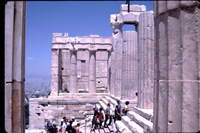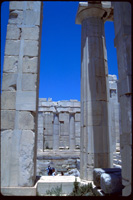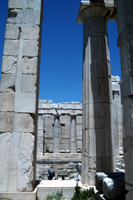
 |
A lesson has been learned. One of the assumptions of the CSA Propylaea Project was that good, affordable slide scanners were available and could be used to scan 35 mm. slides of the Propylaea, both to produce Web images and for archival preservation in TIFF format. In fact, a scanner was built into the project budget, albeit in the second or third year of the project.
When it was decided to digitize some slides sooner, those slides were taken to Bryn Mawr College scanners (two good current-model scanners from different manufacturers) by CSA Administrative Assistant Susan Jones. Ms. Jones spent considerable time and effort getting the best scans possible, manipulating the settings on the scanners and software to adjust resolution and contrast.
The initial results seemed very good until the original slides were compared to the scans. The scanned versions differed as to color and occasionally lacked contrast. Nothing that could be done with CSA software could remedy the situation; the color problems seemed to reflect basic difficulties with scanning large volumes of material at one time, and the low contrast was ultimately ascribed to the scanners' limited ratio of lightest-to-darkest tone recognition (called the dynamic range in scanner specifications).
The same slides were then taken to a Philadelphia suburban digital and professional photography outlet. They were scanned according to their normal procedures (which purportedly included operator intervention and was not totally automatic) at a price of about $1.00 each. The results were considerably worse than those achieved with the scanners on the Bryn Mawr campus.
Finally the same slides were sent to Luna Imaging in California, the company that CSA has used for scanning lantern slides for the Lantern Slides of Classical Antiquity Project. Although the cost rose to $4.00 per slide, the quality rose dramatically. It was still necessary to use PhotoShop's auto-levels command to bring up contrast, but the results were excellent, the colors true, and the sharpness improved.
Thumbnails of two sets of the images are reproduced here so that they may be compared effectively. Each thumbnail will lead to a larger image that will be downloaded to its own window.
| View of the northwest wing from the southwest wing. | ||
|---|---|---|
 |
 |
 |
| Fig. 1 -- Digitized on Bryn Mawr College Equipment | Fig. 2 -- Digitized by Local Photography Outlet | Fig. 3 -- Digitized by Luna Imaging |
| Another view of the northwest wing from southwest wing. | ||
 |
 |
 |
| Fig. 4 -- Digitized on Bryn Mawr College Equipment | Fig. 5 -- Digitized by Local Photography Outlet | Fig. 6 -- Digitized by Luna Imaging |
When slides are being scanned at such high levels of resolution and intended for archival preservation, the higher cost of the good scans becomes a matter of little long-term consequence. The quality differential is far more significant. Thus, while better scanners that can be afforded for the project may appear, the quality will have to be demonstrated before they become preferred equipment at CSA.
For other Newsletter articles concerning the The Propylaea Project, electronic publishing, or the use of electronic media in the humanities, consult the Subject index.
Next Article: Publishing Electronically -- Sooner or Later?
Table of Contents for the Winter, 2001 issue of the CSA Newsletter (Vol. XIII, no. 3)
 Table of Contents for all CSA Newsletter issues on the Web
Table of Contents for all CSA Newsletter issues on the Web